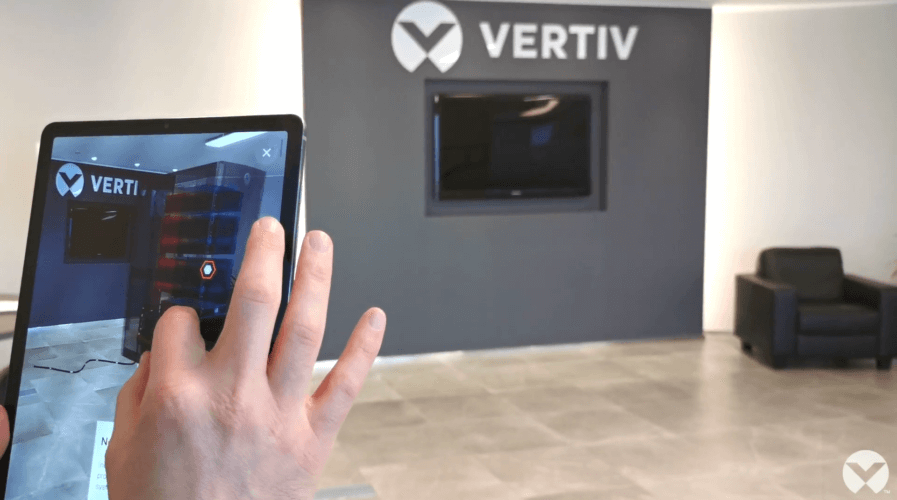
Vertiv’s new innovation in data center management: The impact of augmented reality beyond social media
|
Getting your Trinity Audio player ready... |
- The Vertiv XR app lets users preview and examine equipment in any location before purchasing and installing it.
- The primary benefit of using AR in data center management is its immersive experience, enabling operators to interact with and visualize the data center in real-time.
Augmented reality (AR) has revolutionized the consumer sector, particularly through social media apps like Snapchat, Instagram, Facebook, and TikTok, which have introduced new features and lenses to captivate users. However, the impact of AR extends beyond social media, as gaming and e-commerce apps have also leveraged it to improve their market position. Pokémon Go, with over 600 million downloads, is one of the most famous examples of AR gaming.
The e-commerce sector is also adopting AR and VR, with furniture and makeup apps like Ikea Place, Wayfair, and Sephora leading the way. While AR software dominates the market, AR hardware is still catching up, but this is set to change with Apple’s upcoming AR glasses, which will compete with Microsoft’s HoloLens.
Data Bridge Market Research shows that the Asia-Pacific market for AR and mixed reality (MR) is projected to reach US$ 191,619.41 million by 2029. This growth is expected to continue, with a compound annual growth rate (CAGR) of 51.9% during the forecast period.
As evidence of this trend, Vertiv, which provides critical digital infrastructure, has entered the market by introducing the Vertiv XR app. This virtual tool enables data center operators to visualize their products in their facility, improving planning and support after installation. The app is available on the Apple App Store and Google Play Store.
Vertiv has made strides in digitizing its business, with the release of the Vertiv XR app being the latest advancement in this ongoing initiative. The app, which is the first of its kind to bring commercial-grade technology typically used for home remodeling projects to the data center space, has garnered recognition for its innovative approach to improving the customer experience. The Computing 2022 Technology Product Awards named it “Best Digital Transformation Product or Service – Enterprise,” and IT Channel awarded it a five-star rating, calling it “the best augmented reality app tested in 2022.”
Cristian Scarpa,CIO EMEA & Global VP Customer & Employee Technologies at Vertiv, stated that they designed the app to bridge the gap between in-person physical interactions and digital experiences. “The app allows our customers and partners to make more informed buying decisions and recommendations, to visualize in a tangible way how new products will interact with their existing environments, and explore details about those products, all from the palm of their hand,” he added.

Source – Shutterstock
The app guides users through product selection and placement, providing an immersive and realistic depiction of the product in any location, whether it be a data center, office, lobby, or living room. This app allows users to explore various Vertiv solutions at their own pace and convenience, and even share their experiences with others.
Utilizing augmented reality in data center management
The immersive experience provided by AR is the primary advantage of using it in data center management. AR allows operators to view and interact with the data center in real-time, enabling them to walk through and inspect individual servers and hardware components. Other benefits include improved efficiency, reduced downtime, and better decision-making capabilities.
By providing a 3D view of the data center, AR reduces the need for manual inspection and allows operators to optimize the layout of servers and hardware. This, in turn, helps businesses to stay competitive in the digital age. Additionally, AR can help operators quickly identify and troubleshoot problems in data centers and provide training for employees on how to manage, maintain, and optimize the data center using AR simulations.
“This type of technology has been used for various consumer applications, helping homeowners see how new cabinets might look in their kitchen or different siding may look on their house, but we’ve never seen this type of application in the data center,” said Martin Coulthard, Global Vice President for demand generation marketing at Vertiv. “We’re giving them the opportunity to see this equipment before they buy, enabling them to make their Vertiv purchase with confidence.”
Vertiv’s extensive digitalization initiative aims to create and enhance digital resources that cater to customers and partners and enable them to engage on their own terms. The primary goal is to improve the online interactions between Vertiv and its users, making it more convenient for them to locate what they require when they visit Vertiv.com or use the Vertiv XR app, as well as to facilitate more purposeful and fruitful engagements between Vertiv and its customers and partners.
READ MORE
- Safer Automation: How Sophic and Firmus Succeeded in Malaysia with MDEC’s Support
- Privilege granted, not gained: Intelligent authorization for enhanced infrastructure productivity
- Low-Code produces the Proof-of-Possibilities
- New Wearables Enable Staff to Work Faster and Safer
- Experts weigh in on Oracle’s departure from adland


